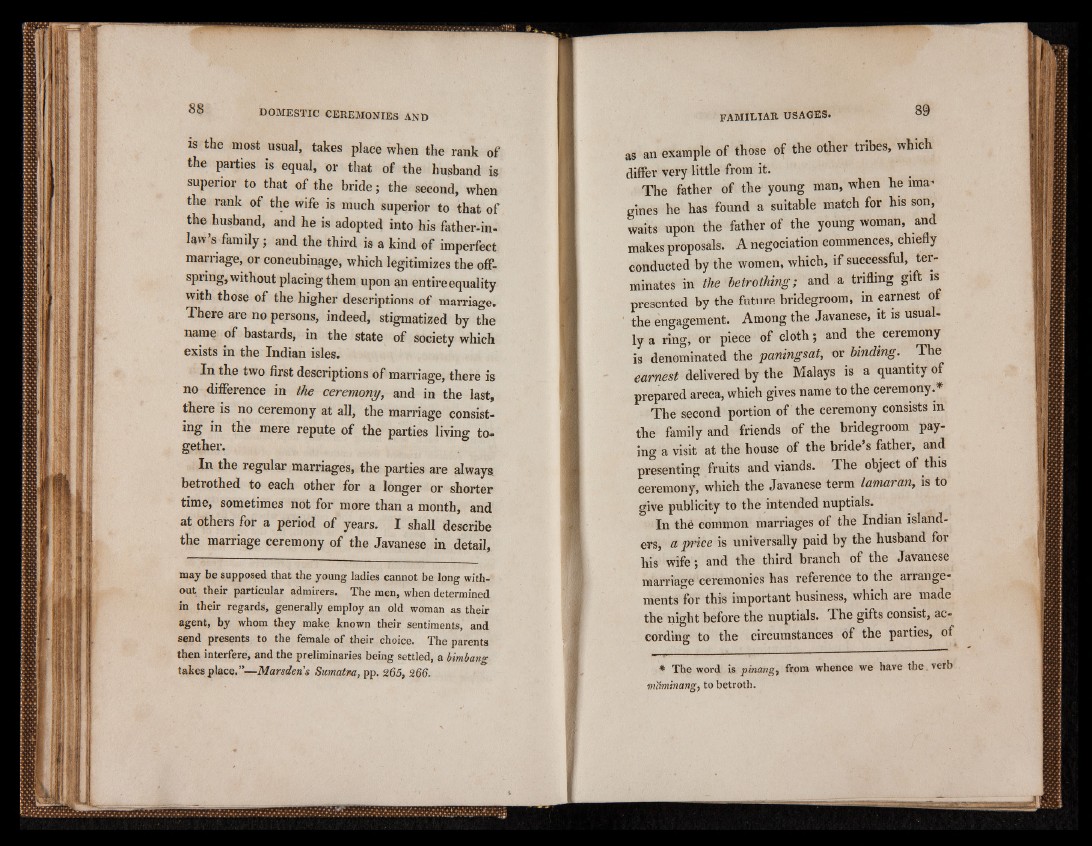
is the most usual, takes place when the rank of
the parties is equal, or that of the husband is
superior to that of the bride; the second, when
the rank of the wife is much superior to that of
the husband, and he is adopted into his father-in-
law s family; and the third is a kind of imperfect
marriage, or concubinage, which legitimizes the offspring,
without placing them upon an entire equality
with those of the higher descriptions of marriage.
There are no persons, indeed, stigmatized by the
name of bastards, in the state of society which
exists in the Indian isles.
In the two first descriptions of marriage, there is
no difference in the ceremony, and in the last,
there is no ceremony at all, the marriage consisting
in the mere repute of the parties living together.
In the regular marriages, the parties are always,
betrothed to each other for a longer or shorter
time, sometimes not for more than a month, and
at others for a period of years. I shall describe
the marriage ceremony of the Javanese in detail,
may be supposed that the young ladies cannot be long without
their particular admirers. The men, when determined
in their regards, generally employ an old woman as their
agent, by whom they make known their sentiments, and
send presents to the female of their choice. The parents
then interfere, and the preliminaries being settled, a bimbang
takes place.”— Marsderis Sumatra, pp. 265, 266.
as an example of those of the other tribes, which
differ very little from it.
The father of the young man, when he ima'
gines he has found a suitable match for his son,
waits upon the father of the young woman, and
makes proposals. A négociation commences, chiefly
conducted by the women, which, if successful, terminates
in the betrothing; and a trifling gift is
presented by the future bridegroom, in earnest of
the engagement. Among the Javanese, it is usually
a ring, or piece of cloth; and the ceremony
is denominated the paningsat, or binding. The
earnest delivered by the Malays is a quantity of
prepared areca, which gives name to the ceremony.*
The second portion of the ceremony consists in
the family and friends of the bridegroom paying
a visit at the house of the bride’s father, and
presenting fruits and viands. The object of this
ceremony, which the Javanese term lamaran, is to
give publicity to the intended nuptials.
In thè common marriages of the Indian islanders,
a price is universally paid by the husband for
his wife ; and the third branch of the Javanese
marriage ceremonies has reference to the arrange*
ments for this important business, which are made
the night before the nuptials. The gifts consist, according
to the circumstances of the parties, of
* The word is pinang, from whence we have th e . verb
maminang, to betroth.